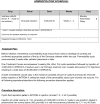Intracystic therapies for cystic craniopharyngioma in childhood
- PMID: 22654864
- PMCID: PMC3356106
- DOI: 10.3389/fendo.2012.00039
Intracystic therapies for cystic craniopharyngioma in childhood
Abstract
Introduction: Craniopharyngioma of childhood are commonly cystic in nature. An intracystic catheter insertion and subsequent instillation of substances inducing cyst shrinkage seems a beneficial strategy avoiding additional morbidity in a highly vulnerable brain location.
Methods: A systematic review of the medical literature was performed to identify potentially relevant, all languages articles using Ovid MEDLINE and EMBASE from inception to July 2011 and Cochrane Central Register of Controlled Trials to third quarter 2011. All references were examined for relevancy.
Results: Of 142 unique references, 71 referred to substances used for intracystic craniopharyngioma treatment. General aspects of intracystic catheter insertion as well as response rates, risks, and outcomes of children treated with intracystic radioisotopes, bleomycin, and interferon (IFN) are critically reviewed and an outline for potential future endeavors provided.
Conclusion: IFN seems currently the intracystic substance with the best benefit risk ratio. The authors advocate for consensus on prospective data collection and standardized intracystic treatment strategies to allow reliable comparisons and herewith optimize treatment and outcome.
Keywords: bleomycin; children; craniopharyngioma; interferon; intracystic therapy; radioisotopes.
Figures
References
-
- Alen J. F., Boto G. R., Lagares A., de la Lama A., Gomez P. A., Lobato R. D. (2002). Intratumoural bleomycin as a treatment for recurrent cystic craniopharyngioma. Case report and review of the literature. Neurocirugia (Astur) 13, 479–485; discussion 485. - PubMed
-
- Backlund E. O. (1973). Studies on craniopharyngiomas. 3. Stereotaxic treatment with intracystic yttrium-90. Acta Chir. Scand. 139, 237–247 - PubMed
-
- Backlund E. O. (1989). Colloidal radioisotopes as part of a multi-modality treatment of craniopharyngiomas. J. Neurosurg. Sci. 33, 95–97 - PubMed
LinkOut - more resources
Full Text Sources




